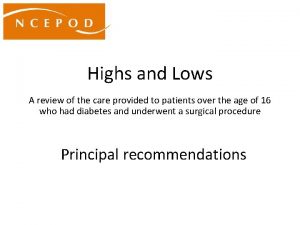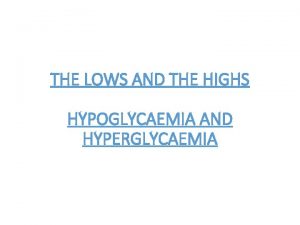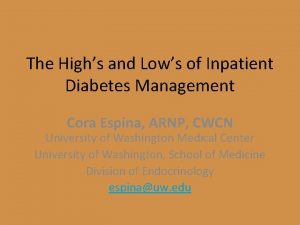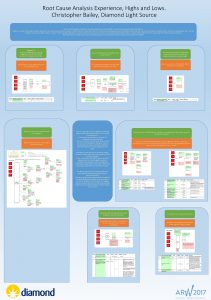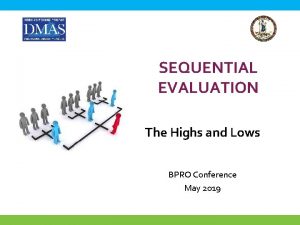Highs and Lows A review of the care
















- Slides: 16

Highs and Lows A review of the care provided to patients over the age of 16 who had diabetes and underwent a surgical procedure Principal recommendations

The study Review of the care provided to patients over the age of 16 who had diabetes and underwent a surgical procedure – Organisational questionnaire – Surgical questionnaire – Anaesthetic questionnaire – Case note review

Study population • Patients aged 16 and over • Admitted to hospital either as an emergency or for an elective procedure with an ICD 10 code for diabetes mellitus (E 10. 0 -E 11. 9) • A major surgical procedure with a minimum one night stay post-surgery between 1 st February 2017 and 31 st March 2017.

Study sample

Overall assessment of care

Key messages (1) • Lack of clinical continuity of diabetes management across the different specialties in the perioperative pathway • Absence of joint ownership of the diabetes management • Multiple guidelines targeted at specific specialties, rather than a joint multidisciplinary approach, creating gaps in the surgical pathway

Key messages (2) • Under-involvement of key diabetes team members • Nutritional assessments and medicine reconciliations were frequently not undertaken • Patients were not prioritised appropriately, which subjected them to prolonged fasting • Regular monitoring of blood glucose was under-utilised pre-, intra- and post-operatively

Recommendation 1 Write and implement a national joint standard and policy for the multidisciplinary management of patients with diabetes who require surgery. Information should include responsibilities for diabetes management across all specialties during routine care and in high-risk patients.

Recommendation 2 Appoint a clinical lead for perioperative diabetes care in hospitals where surgical services are provided. This person will be responsible for developing policies and processes to: a. Ensure diabetes management is optimised for surgery b. Ensure patients with diabetes are prioritised on the operating list, including the co-ordination of emergency surgery c. Identify when involvement of the diabetes multidisciplinary team, including diabetes specialist nurse, is required

Recommendation 2 Appoint a clinical lead for perioperative diabetes care in hospitals where surgical services are provided. This person will be responsible for developing policies and processes to: d. Ensure high-risk patients are identified, such as those with type 1 diabetes e. Identify patients with poor diabetes control who may need pre-operative optimisation or variable rate intravenous insulin infusion (VRIII) f. Audit cases of prolonged starvation g. Ensure high-quality discharge planning.

Recommendation 3 Use a standardised referral process for elective surgery to ensure appropriate assessment and optimisation of diabetes. This should include: a. Satisfactory Hb. A 1 c levels within 3 months of referral b. Control of co-morbidities c. A list of all current medications d. The patient’s body mass index (BMI) e. Estimated glomerular filtration rate (e. GFR) f. Perioperative risk rating.

Recommendation 4 Ensure that patients with diabetes undergoing surgery are closely monitored and their glucose levels managed accordingly. Glucose monitoring should be included: a. at sign-in and sign-out stages of the surgical safety checklist (e. g. WHO safety checklist) b. in anaesthetic charts c. in theatre recovery d. in early warning scoring systems

Recommendation 4 System markers and alerts should be used to raise awareness of glucose levels, e. g. tagging of electronic medical records, use of a patient passport or unique stickers in paper-based case notes.

Recommendation 5 Ensure a safe handover of patients with diabetes from theatre recovery to ward, this should be documented in the case notes and include: a. Medications given in theatre b. Glucose level on leaving the recovery area c. Glucose level on arriving into the ward d. Ongoing management of diabetes, especially VRIII e. Criteria for contacting the diabetes team.

Discussion • Do we have a clinical lead for perioperative diabetes care? • Do we have policies and processes for perioperative care? • Is there a standard referral process? • Are system markers and alerts used? • How well is handover carried out?

Highs and Lows Full report, summary and implementation tools are be found at www. ncepod. org. uk/2018 pd. html
 From the highest of heights to the depths of the sea
From the highest of heights to the depths of the sea Polar lows
Polar lows Health care levels primary secondary tertiary
Health care levels primary secondary tertiary Care value base health and social care
Care value base health and social care Hát kết hợp bộ gõ cơ thể
Hát kết hợp bộ gõ cơ thể Ng-html
Ng-html Bổ thể
Bổ thể Tỉ lệ cơ thể trẻ em
Tỉ lệ cơ thể trẻ em Chó sói
Chó sói Tư thế worm breton
Tư thế worm breton Chúa yêu trần thế
Chúa yêu trần thế Các môn thể thao bắt đầu bằng tiếng chạy
Các môn thể thao bắt đầu bằng tiếng chạy Thế nào là hệ số cao nhất
Thế nào là hệ số cao nhất Các châu lục và đại dương trên thế giới
Các châu lục và đại dương trên thế giới Công thức tính thế năng
Công thức tính thế năng Trời xanh đây là của chúng ta thể thơ
Trời xanh đây là của chúng ta thể thơ Mật thư anh em như thể tay chân
Mật thư anh em như thể tay chân


















